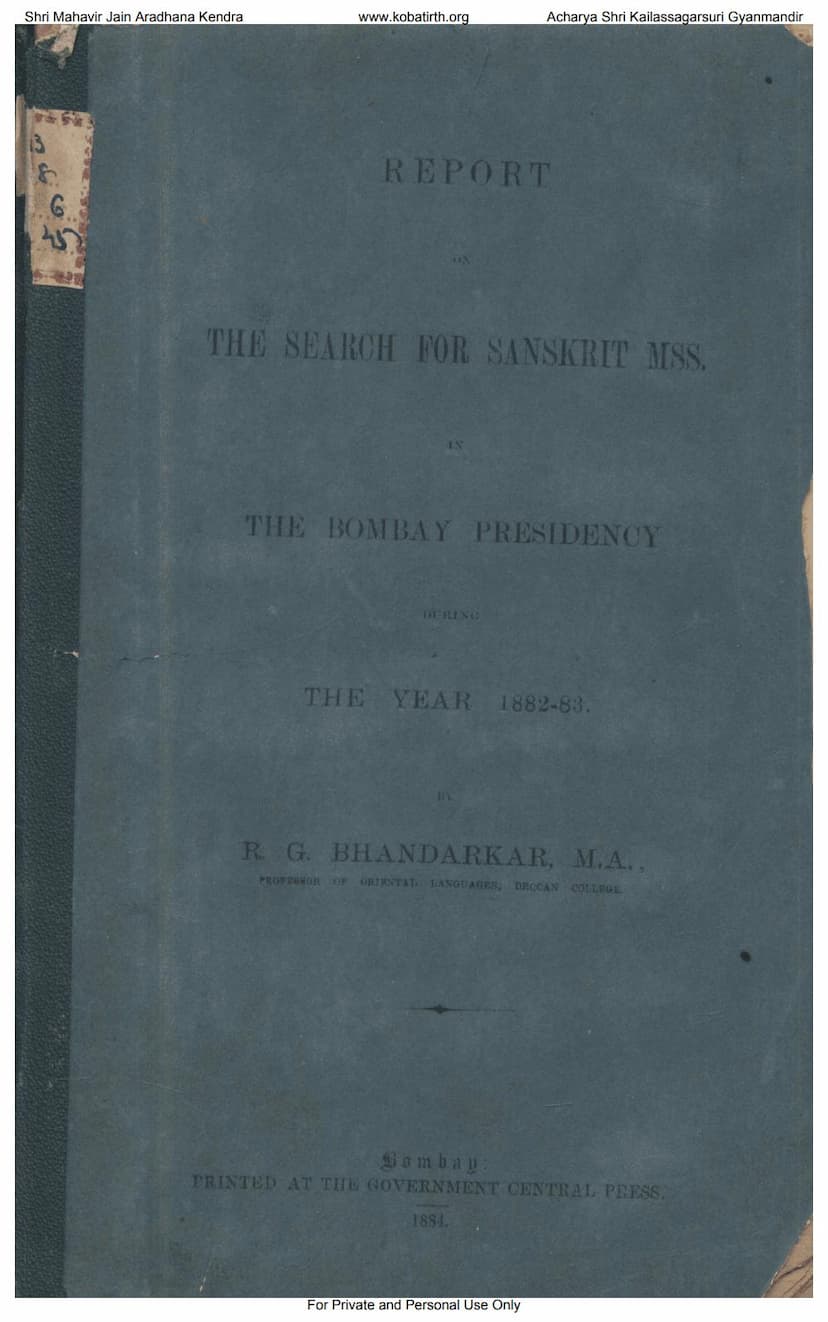Report On Search For Sanskrit MSS Year 1882 1883
Added to library: September 2, 2025

Summary
This document is the "Report on the Search for Sanskrit MSS. in the Bombay Presidency During the Year 1882-83" by R. G. Bhandarkar, published by the Government Central Book Depot in 1884. It details the efforts made to collect and catalogue Sanskrit manuscripts within the Bombay Presidency during that period.
Here's a comprehensive summary of its content:
Overall Purpose: The report outlines the activities undertaken to find, acquire, and preserve Sanskrit manuscripts, categorizing them and providing details about their age, authorship, content, and condition. It also addresses the expenditure involved in this endeavor.
Key Sections and Findings:
-
Expenditure: The report details the financial outlay for the search, noting the division of funds between Professor Peterson and the author. It specifies the costs associated with purchasing manuscripts, paying agents and Sastris for their work, and covering traveling expenses.
-
Manuscript Collection and Analysis: The core of the report is the detailed cataloguing and analysis of the collected manuscripts, which are divided into two main sections:
- Gujarat Section (Nos. 1-486): Manuscripts collected from Gujarat.
- Maratha Country Section (Nos. 487-772): Manuscripts collected from the Maratha territories.
-
Classification of Manuscripts: The manuscripts are systematically classified into fifteen major categories, reflecting the breadth of Sanskrit literature. These include:
- Class I: Vedas including Upanishads: Discusses various Vedic texts like the Samhitas, Brahmanas, and a significant collection of Upanishads, including the Ashtottaraśatopanishad. It highlights the antiquity of some of these texts.
- Class II: Vedangas and Sacrificial Manuals: Covers texts related to Vedic ritual and grammar.
- Class III: Itihasas, Puranas, Mahatmyas and Stotras: Details the acquisition of epics like the Mahabharata and various Puranic texts and hymns, emphasizing the aim of procuring materials for critical editions.
- Class IV: Dharmaśâstra or Religious and Civil Law: Lists various Smriti texts and commentaries, including important works on Hindu law and rituals. It notes the acquisition of an old copy of the Mitâkshara and a valuable commentary on the Manu Smriti.
- Class V: Poems, Plays, Fables, &c.: Encompasses a variety of literary works, including commentaries on classical poems, dramas, and fables. It mentions specific poets and their works, often providing biographical details and historical context.
- Class VI: Vyakarana or Grammar: Lists grammatical treatises, including commentaries on the Mahabhâshya, and works from other grammatical schools.
- Class VII: Koshas or Lexicons: Details the collection of dictionaries and lexicographical works.
- Class VIII: Poetics and Metrics: Includes works on literary criticism, rhetoric, and prosody.
- Class IX: Sankhya and Yoga: Covers philosophical works belonging to the Sankhya and Yoga systems.
- Class X: Vedanta: A significant portion dedicated to the Vedanta philosophy, detailing works from Shankaracharya's Advaita system and Madhva's Dvaita system, as well as those of Ramanuja and Nimbarka. It delves into doctrinal comparisons and provides historical information about the founders and their schools.
- Class XI: Nyaya and Vaiseshika Systems: Focuses on logical and atomic philosophical systems, mentioning key texts and commentaries.
- Class XII: Jyotisha (Astronomy, Astrology, and Divination): A comprehensive collection of works on astronomy, astrology, horoscopy, and divination, with detailed accounts of authors and their contributions.
- Class XIII: Medicine (Vaidyaka): Includes works on Hindu medical science, mentioning fragments of major texts and works by Bopadeva.
- Class XIV: Tantrika Literature: Lists manuscripts related to Tantric practices and rituals.
- Class XV: Art (Śilpa and Samgita): Covers works on architecture, music, and other technical arts.
- Class XVI: Miscellaneous: Includes works of historical importance, such as the Lekhapañchâśikâ, which contains forms of official documents and provides significant historical insights.
- Class XVII: Jaina Literature: A substantial section dedicated to Jaina works in Sanskrit and Prakrit, covering Sutras, commentaries, grammar, lexicons, plays, and historical/biographical works. It mentions key Jaina scholars and their contributions.
- Class XVIII: Brahmaniya Works in the Vernacular: Lists Sanskrit works written in vernacular languages.
-
Specific Manuscript Details: For each manuscript, the report typically provides:
- Its serial number.
- The name of the work.
- The author's name (if known).
- The number of leaves.
- Details about the number of lines per page and letters per line.
- The "Age" or date of transcription (Samvat or Saka era, often converted to A.D.).
- Remarks, including the condition of the manuscript (complete, incomplete, missing leaves), specific content, or comparisons with other copies.
-
Historical and Biographical Information: Beyond cataloguing, Bhandarkar often includes valuable historical and biographical details about the authors, patrons, and the context in which these works were composed or transmitted. This includes information about royal patronage, geographical locations, and interconnections between different schools of thought.
-
Manuscript Age and Material: The report also discusses the age of the manuscripts, differentiating between those written on palm-leaves and paper. It notes the transition from palm-leaf to paper usage in Gujarat and the earliest dated manuscripts found.
-
Appendices: The report is accompanied by extensive appendices (Appendix I being the primary catalogue and Appendix II providing further supporting details and excerpts).
In essence, this report is a significant academic work detailing a meticulous effort to document and understand the vast landscape of Sanskrit literature available in the Bombay Presidency in the late 19th century. It serves as a valuable historical record of manuscript collection and a foundational resource for scholars of Indian literature, philosophy, law, science, and history.